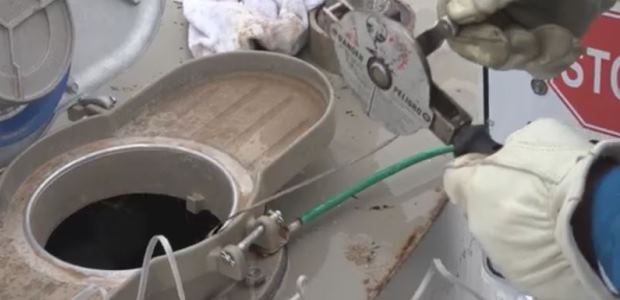
New Video Addresses Tank Gauging Hazards
It relates the experiences of oil and gas workers who are responsible for tank gauging and sampling crude oil through comments by a truck owner/operator, a company operations superintendent, and the widow and son of a man who died of sudden cardiac death while gauging. The video also illustrates engineering and other controls to prevent injuries and discusses the new API 18.2 standard for safely measuring oil levels.
NIOSH and the California Department of Public Health's Occupational Health Branch (CDPH-OHB) have released a video to help protect oil and gas extraction workers from hazards they face during oil tank gauging -- manually measuring the level of oil in storage tanks. The 13:25 video, "Protecting Oil and Gas Workers from Hydrocarbon Gases and Vapors," discusses the health and safety risks involved with this activity and how employers and workers can reduce injuries and fatalities from exposure to toxic gases and oxygen-deficient atmospheres.
It relates the experiences of oil and gas workers who are responsible for tank gauging and sampling crude oil through comments by a truck owner/operator, a company operations superintendent, and the widow and son of a man who died of sudden cardiac death while gauging. The video also illustrates engineering and other controls to prevent injuries and discusses the new API 18.2 standard for safely measuring oil levels.
"These workers often work long shifts, the weather can be severe, and many work at night or alone," according to NIOSH. "From 2010-2014, there were at least 9 deaths associated with exposure to a mixture of hydrocarbon gas and insufficient oxygen when the thief hatch at the top of the storage tank was opened. The results of an overexposure can be immediate; the gases affect eyes, lungs and the central nervous system, and can cause the heart to have abnormal rhythms resulting in dizziness and disorientation, loss of consciousness, and even sudden cardiac death."
The video covers information in the 2016 NIOSH-OSHA Hazard Alert: Health and Safety Risks for Workers Involved in Manual Tank Gauging and Sampling at Oil and Gas Extraction Sites and describes and demonstrates these recommendations:
- Employers should implement engineering controls that eliminate the need to open tank hatches (thief hatches); conduct hazard assessments and determine necessary controls to protect workers; communicate information to on-site workers and off-site contractors; and train workers on proper use of controls and in emergency response procedures.
- Workers should inform designated personnel when beginning and finishing work; remove all items that could spark or ignite flammable gas; wear appropriate PPE, including a properly calibrated and tested multi-gas monitor; bleed off pressure using the right tools; determine wind direction when manually gauging; and stay informed.